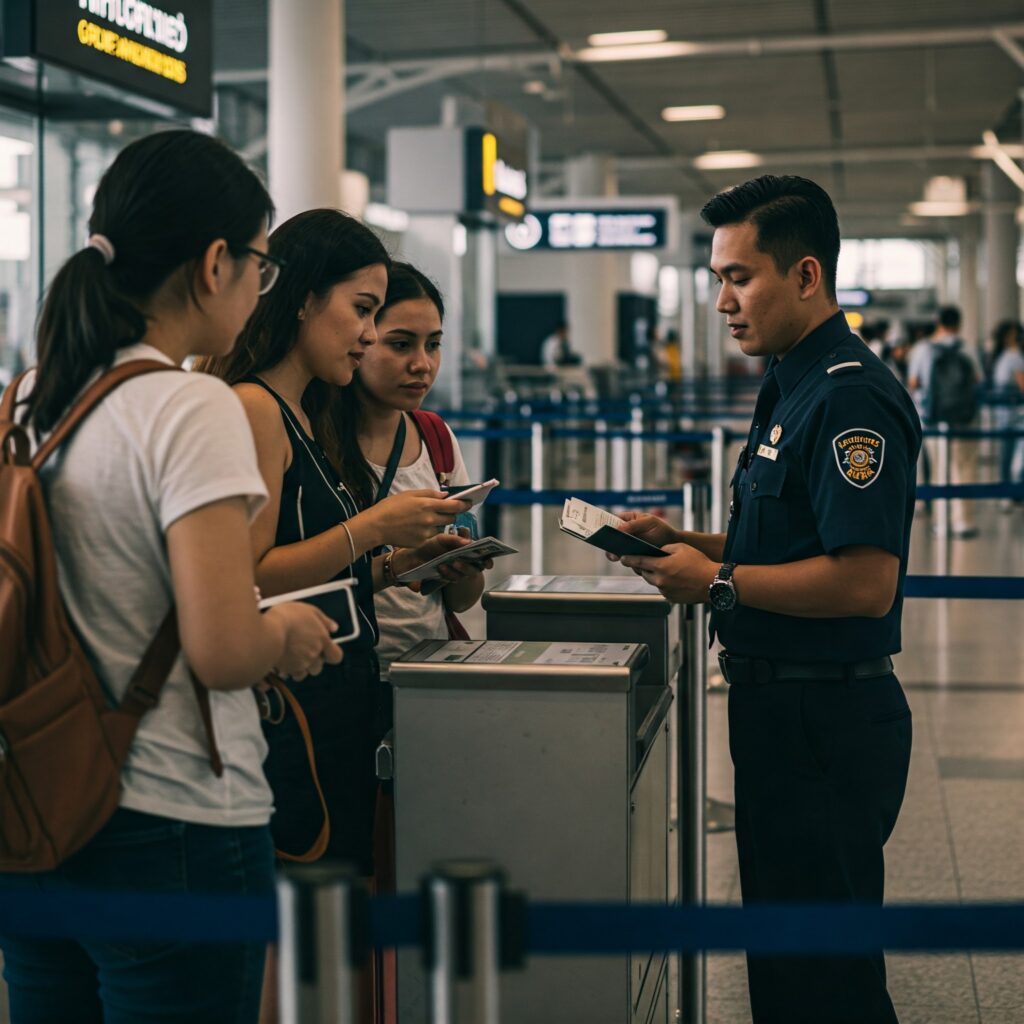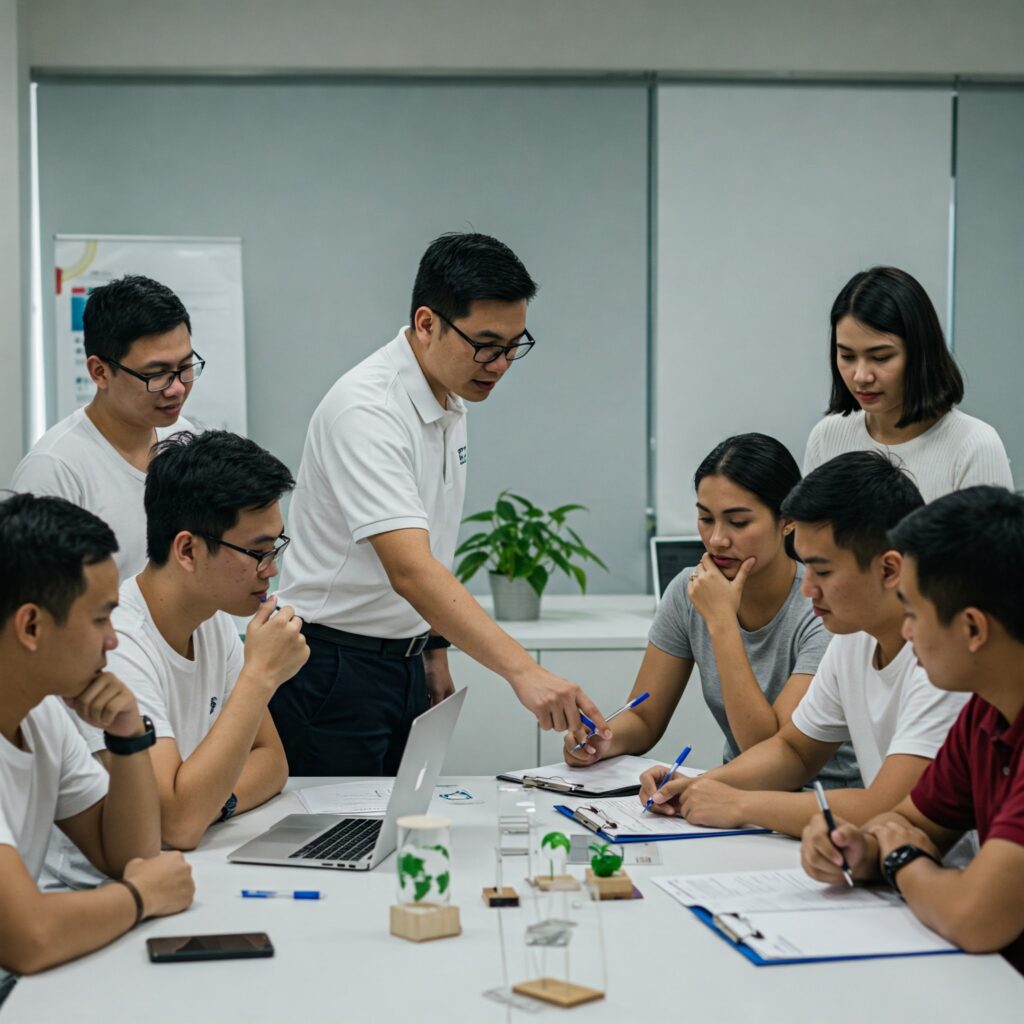The Philippines, an archipelago of over 7,000 islands, beckons travelers with its stunning beaches, vibrant culture, and warm hospitality. But before you pack your bags and book that flight, there’s a crucial step you can’t skip: understanding the ins and outs of the Bureau of Immigration (BI) and its visa policies.
Think of the BI as the gatekeeper of this tropical paradise, ensuring that everyone who enters has the right documentation and intentions. Navigating these policies might seem as daunting as island hopping in a storm, but fear not, fellow adventurers! This guide will equip you with the knowledge you need to sail smoothly through the immigration process and make your Philippine dream a reality.
Why the BI Matters: More Than Just a Rubber Stamp
The BI isn’t just about stamping passports and collecting fees (though they do that too!). Their primary role is to regulate the flow of people into and out of the Philippines. This includes:
- Protecting national security: The BI screens individuals to prevent the entry of those who might pose a threat to the country.
- Upholding immigration laws: They enforce the rules and regulations related to entry, stay, and exit of foreign nationals.
- Facilitating travel: The BI strives to make the immigration process as efficient as possible for legitimate travelers.
So, before you picture stern-faced officers scrutinizing your every move, remember that the BI is there to ensure a safe and orderly travel experience for everyone.
Visa Visas Baby! Decoding Philippine Visa Policies
The Philippines offers a variety of visa types, each catering to different purposes of travel. Choosing the right one is crucial, so let’s break it down:
1. Visa-Free Entry:
For many nationalities, the Philippines offers a taste of paradise without the visa hassle. You can enter visa-free for tourism or business purposes for a limited period, typically 30 days.
Always check the latest regulations based on your nationality, as the visa-free period can vary.
2. Visa Required:
If your nationality isn’t on the visa-free list, don’t fret! You can apply for a visa at the nearest Philippine embassy or consulate in your home country. Common types of visas include:
- Tourist Visa: For leisure, sightseeing, and visiting friends and family.
- Business Visa: For attending meetings, conferences, or exploring business opportunities.
- Student Visa: For those seeking to study in the Philippines.
- Work Visa: For individuals with a job offer in the Philippines.
3. Special Visas:
The Philippines also offers special visas for specific circumstances, such as:
- Special Resident Retiree’s Visa (SRRV): For foreign nationals who wish to retire in the Philippines.
- Special Investor’s Resident Visa (SIRV): For investors looking to contribute to the Philippine economy.
4. Visa Extensions:
If you find yourself falling in love with the Philippines and wish to extend your stay (and who wouldn’t?), you can apply for a visa extension at the BI office. Just make sure to do so before your current visa expires to avoid any penalties.
Visa-Free Entry: Countries and Duration of Stay
| Nationality | Duration of Stay |
|---|---|
| Andorra | 30 days |
| Angola | 30 days |
| Antigua and Barbuda | 30 days |
| Argentina | 30 days |
| Australia | 30 days |
| Austria | 30 days |
| Bahamas | 30 days |
| Bahrain | 30 days |
| Bangladesh | 14 days |
| Barbados | 30 days |
| Belgium | 30 days |
| Belize | 30 days |
| Benin | 30 days |
| Bhutan | 14 days |
| Bolivia | 30 days |
| Botswana | 30 days |
| Brazil | 30 days |
| Brunei | 14 days |
| Bulgaria | 30 days |
| Burkina Faso | 30 days |
| Burundi | 30 days |
| Cambodia | 30 days |
| Cameroon | 30 days |
| Canada | 30 days |
| Cape Verde | 30 days |
| Central African Republic | 30 days |
| Chad | 30 days |
| Chile | 30 days |
| China | 30 days |
| Colombia | 30 days |
| Comoros | 30 days |
| Congo | 30 days |
| Costa Rica | 30 days |
| Côte d’Ivoire | 30 days |
| Croatia | 30 days |
| Cuba | 30 days |
| Cyprus | 30 days |
| Czech Republic | 30 days |
| Denmark | 30 days |
| Djibouti | 30 days |
| Dominica | 21 days |
| Dominican Republic | 21 days |
| Ecuador | 30 days |
| Egypt | 30 days |
| El Salvador | 30 days |
| Equatorial Guinea | 30 days |
| Eritrea | 30 days |
| Estonia | 30 days |
| Eswatini | 30 days |
| Ethiopia | 30 days |
| Fiji | 30 days |
| Finland | 30 days |
| France | 30 days |
| Gabon | 30 days |
| Gambia | 30 days |
| Georgia | 30 days |
| Germany | 30 days |
| Ghana | 30 days |
| Greece | 30 days |
| Grenada | 30 days |
| Guatemala | 30 days |
| Guinea | 30 days |
| Guinea-Bissau | 30 days |
| Guyana | 30 days |
| Haiti | 30 days |
| Honduras | 30 days |
| Hungary | 30 days |
| Iceland | 30 days |
| India | 30 days |
| Indonesia | 30 days |
| Iran | 30 days |
| Ireland | 30 days |
| Israel | 59 days |
| Italy | 30 days |
| Jamaica | 30 days |
| Japan | 30 days |
| Jordan | 30 days |
| Kazakhstan | 30 days |
| Kenya | 30 days |
| Kiribati | 30 days |
| Kuwait | 30 days |
| Kyrgyzstan | 30 days |
| Laos | 30 days |
| Latvia | 30 days |
| Lebanon | 30 days |
| Lesotho | 30 days |
| Liberia | 30 days |
| Libya | 30 days |
| Liechtenstein | 30 days |
| Lithuania | 30 days |
| Luxembourg | 30 days |
| Madagascar | 30 days |
| Malawi | 30 days |
| Malaysia | 30 days |
| Maldives | 30 days |
| Mali | 30 days |
| Malta | 30 days |
| Marshall Islands | 30 days |
| Mauritania | 30 days |
| Mauritius | 30 days |
| Mexico | 30 days |
| Micronesia | 30 days |
| Moldova | 30 days |
| Monaco | 30 days |
| Mongolia | 30 days |
| Montenegro | 30 days |
| Morocco | 30 days |
| Mozambique | 30 days |
| Myanmar | 14 days |
| Namibia | 30 days |
| Nauru | 30 days |
| Nepal | 30 days |
| Netherlands | 30 days |
| New Zealand | 30 days |
| Nicaragua | 30 days |
| Niger | 30 days |
| Nigeria | 30 days |
| Norway | 30 days |
| Oman | 30 days |
| Palau | 30 days |
| Palestine | 30 days |
| Panama | 30 days |
| Papua New Guinea | 30 days |
| Paraguay | 30 days |
| Peru | 30 days |
| Poland | 30 days |
| Portugal | 30 days |
| Qatar | 30 days |
| Romania | 30 days |
| Russia | 30 days |
| Rwanda | 30 days |
| Saint Kitts and Nevis | 30 days |
| Saint Lucia | 30 days |
| Saint Vincent and the Grenadines | 30 days |
| Samoa | 60 days |
| San Marino | 30 days |
| Sao Tome and Principe | 30 days |
| Saudi Arabia | 30 days |
| Senegal | 30 days |
| Serbia | 30 days |
| Seychelles | 30 days |
| Sierra Leone | 30 days |
| Singapore | 30 days |
| Slovakia | 30 days |
| Slovenia | 30 days |
| Solomon Islands | 30 days |
| Somalia | 30 days |
| South Africa | 30 days |
| South Korea | 30 days |
| South Sudan | 30 days |
| Spain | 30 days |
| Sri Lanka | 30 days |
| Sudan | 30 days |
| Suriname | 30 days |
| Sweden | 30 days |
| Switzerland | 30 days |
| Syria | 30 days |
| Taiwan | 14 days |
| Tajikistan | 30 days |
| Tanzania | 30 days |
| Thailand | 30 days |
| Timor-Leste | 30 days |
| Togo | 30 days |
| Tonga | 30 days |
| Trinidad and Tobago | 30 days |
| Tunisia | 30 days |
| Turkey | 30 days |
| Turkmenistan | 30 days |
| Tuvalu | 30 days |
| Uganda | 30 days |
| Ukraine | 30 days |
| United Arab Emirates | 30 days |
| United Kingdom | 30 days |
| United States of America | 30 days |
| Uruguay | 30 days |
| Uzbekistan | 30 days |
| Vanuatu | 30 days |
| Vatican City | 30 days |
| Venezuela | 30 days |
| Vietnam | 30 days |
| Yemen | 30 days |
| Zambia | 30 days |
| Zimbabwe | 30 days |
Source: Bureau of Immigration – Visa-free Entry
Visa Application: Paperwork? No Sweat!
Applying for a Philippine visa might seem like scaling a mountain of paperwork, but with the right preparation, it’s more like a leisurely hike. Here’s a general overview of the process:
- Gather your documents: This typically includes a completed application form, passport with at least six months validity, recent photos, proof of travel itinerary, and financial documents.
- Pay the visa fee: The fee varies depending on the type of visa and your nationality.
- Submit your application: You can submit your application in person or by mail to the nearest Philippine embassy or consulate.
- Attend an interview (if required): Some visa types may require an interview with a consular officer.
- Wait for processing: Visa processing times vary, so it’s best to apply well in advance of your trip.
- Claim your visa: Once approved, you can claim your visa in person or have it mailed to you.
Pro Tip: Check the specific requirements for your visa type and nationality on the website of the Philippine embassy or consulate in your home country. They often have detailed checklists and helpful guides to make the process smoother.
Immigration Processes: Smooth Sailing Upon Arrival
Congratulations, you’ve got your visa (or you’re from a visa-free country)! Now, what awaits you at the Philippine immigration counter? Don’t worry, it’s usually a breeze.
- Fill out the arrival card: You’ll receive an arrival card on your flight, which you need to complete with your personal and travel information.
- Present your documents: Have your passport, visa (if applicable), and return ticket ready for the immigration officer.
- Answer questions (if any): The officer may ask you a few questions about your purpose of visit and length of stay. Just answer truthfully and confidently.
- Get your passport stamped: Once everything checks out, the officer will stamp your passport with your allowed duration of stay.
- Welcome to the Philippines! Now you’re free to explore this beautiful country.
Pro Tip: Keep your immigration arrival card safe, as you’ll need to present it upon departure.
Travel Requirements: Packing List Essentials
Besides your passport and visa, here are a few other essential things to keep in mind for your trip to the Philippines:
- Return or onward ticket: You’ll need to show proof that you have a ticket to leave the Philippines within your allowed duration of stay.
- Proof of accommodation: While not always required, it’s a good idea to have a hotel booking or other proof of where you’ll be staying.
- Sufficient funds: Make sure you have enough money to cover your expenses during your trip.
- Travel insurance: It’s always wise to have travel insurance in case of unexpected events.
Pro Tip: Check the latest travel advisories and health requirements before your trip, as these can change depending on global circumstances.
Bureau of Immigration: Your Friendly Neighborhood (Well, Almost) Office
The BI has offices throughout the Philippines, ready to assist you with various immigration-related matters. Here are some of their key services:
- Visa extensions and renewals: If you need to stay longer, the BI can help you extend your visa.
- Change of status: If your purpose of visit changes (e.g., from tourist to student), you can apply for a change of status.
- Immigration clearances: Certain activities, like employment or marriage to a Filipino citizen, may require an immigration clearance.
- Report of arrival: Foreign nationals staying in the Philippines for more than 59 days are required to report their arrival to the BI.
Pro Tip: The BI website (immigration.gov.ph) is a treasure trove of information on their services, requirements, and latest announcements. Bookmark it and refer to it often!
E-Services: Immigration Goes Digital
In this digital age, the BI has embraced technology to make immigration processes more convenient. Their online portal offers various e-services, such as:
- Online visa application: For certain visa types, you can skip the trip to the embassy and apply online.
- Online visa extension: Extend your stay without leaving the comfort of your hotel room.
- Online payment: Pay your visa fees and other immigration fees online.
- Appointment system: Schedule an appointment at your preferred BI office to avoid long queues.
Pro Tip: Take advantage of these e-services to save time and effort. Just make sure to have a stable internet connection and all your documents ready in digital format.
Common Immigration Issues: Troubleshooting Tips
Even with the best preparation, things can sometimes go wrong. Here are a few common immigration issues and how to address them:
- Visa denial: If your visa application is denied, don’t panic. The embassy or consulate will usually provide a reason for the denial. You can address the issue and reapply, or appeal the decision.
- Overstaying your visa: Overstaying can lead to fines, detention, and even deportation. Make sure to extend your visa before it expires or depart on time.
- Lost or stolen passport: If you lose your passport, report it to the nearest police station and your embassy or consulate immediately. They can assist you in getting a replacement travel document.
- Immigration scams: Be wary of individuals offering “assistance” with immigration processes for a fee. Always deal directly with the BI or authorized agents.
Pro Tip: If you encounter any immigration issues, don’t hesitate to seek assistance from the BI or your embassy or consulate. They are there to help you navigate the process and resolve any problems.
Tips for a Smooth Immigration Experience
Here are a few final tips to ensure a hassle-free immigration experience in the Philippines:
- Be prepared: Gather all the required documents, check the latest regulations, and plan your trip well in advance.
- Be honest and respectful: Answer all questions truthfully and politely when interacting with immigration officers.
- Be patient: Immigration processes can sometimes take time, so be patient and understanding.
- Be informed: Stay updated on the latest immigration policies and announcements through the BI website and other reliable sources.
Pro Tip: A smile and a friendly attitude can go a long way in making your immigration experience more pleasant.
Enjoy Your Philippine Adventure!
Navigating the Bureau of Immigration and visa policies might seem like a challenge, but with the right information and preparation, it’s entirely manageable. So, don’t let the immigration process dampen your excitement for your Philippine adventure. Embrace the journey, explore the beauty of this island nation, and create memories that will last a lifetime!
*Disclaimer: The information provided in this blog is intended for general guidance and informational purposes only, and does not constitute professional legal advice. While we strive to keep the information accurate and up-to-date, we make no representations or warranties of any kind, express or implied, about the completeness,1 accuracy, reliability, suitability, or availability with respect to the2 information contained in this blog. Any reliance you place on such information is therefore strictly at your own risk.3 Please consult with the relevant authorities or legal professionals for specific advice and guidance on immigration matters. If you find any inaccuracies in the information presented here, we kindly request you to report




